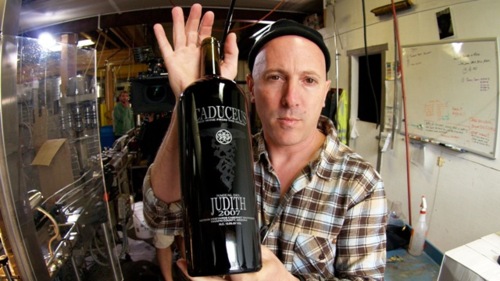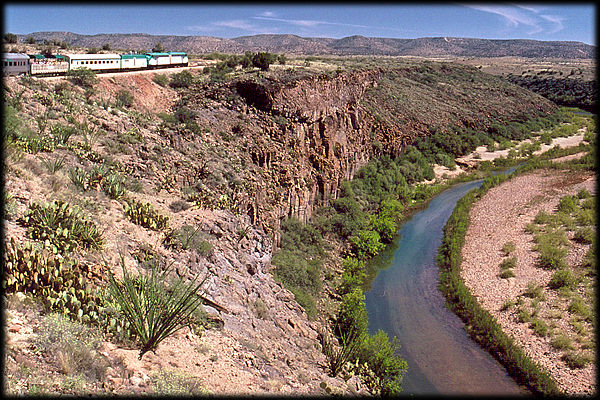Wine Film Review
Film: Blood into Wine
Setting: Arizona, USA
Tags: wine, Arizona,
Tool, Maynard Keenan, Perfect Circle, Puscifer, Eric Glomski, desert, music, Caduceus
Cellars, winery, winemakers, commerce, grapevines, New Napa Valley
In the
United States, the four major wine growing states include New York, Oregon,
Washington State, and California. The film, Blood
into Wine, takes place in the Verde Valley of Arizona, an unexpected setting
to an amateur wine enthusiast. South-central Arizona is best known for its unique
climate, hot summers and quiet, mild winters. Blood into Wine is a documentary that sheds light on the wine
making practices of Caduceus Cellars, a winery located in this region. Owners Maynard James Keenan and Eric Glomski humorously
explain the origin of Caduceus Cellars and Merkin Vineyards, the phases of the wine
making process, winemaker tests and trials, and other challenges in the
wine-making industry.
Verde Valley, Arizona
The
Verde Valley has some climate and soil characteristics that are similar to some
of the great wine producing regions of the world. Fruit is able to fully ripen
in the sunshine and Arizona heat. What is distinct to Arizona is the soil.
Keenan explains that the soils are much rockier and volcanic than other soil
types in places like California, Washington, and New York. In the film, he
describes the point in time where he first considered growing grapes in
Arizona. Keenan had no prior intensive experience in wine-making, nor did he
know what challenges awaited in producing wine on Arizona soil. Keenan’s
Grandfather, “Spirito” Marzo, had vineyards and made wine in Venaus, Italy, North
of Turino in Piemonte. Keenan saw that there were a few other winemakers in
Arizona’s Verde Valley region and visualized himself cultivating his own
vineyard on the same land. Calling on his friend, Eric Glomski, the two were
able to succeed in planting grapevines at Merkin Vineyards.
Merkin Vinyards sloped terrain
Unlike California where yields are fruitful
almost every year, the soils and stressful growing conditions force grapevines
to struggle to survive in the Arizona climate. Moreover, Maynard’s yield is
planted on the face of a mountain, where vines are planted meticulously to
optimize sun exposure and reduce erosion in damaging weather. In the movie,
Glomski and Keenan drive home the principal that winemaking is 90 percent
labor. Wine growers are required to prune the vines, water the vines, monitor
soil acidity, fertilize, harvest, processing, and protect the vineyard from
other forces of the wilderness (ie. pest control management). Despite the
challenges of climate, terrain, and wild animals partaking in Maynard’s grape
stock, he and Glomski successfully produced at Merkin Vinyards. This first
batch of Cabernet Sauvignon was called “Nagual del Judith,” which was a wine
produced to honor the passing of his mother, Judith Marie. Blood into Wine also provides insight on Keenan’s music career and responses
from critics on Arizona wines.
Keenan with a bottle of Nagual del Judith
For
years, Keenan toured with Tool, A Perfect Circle, and Puscifer across the
globe. However, in the film he explained that he would not tour as he once did after
investing in Merkin Vineyards and Caduceus Cellars. Perhaps the information on his music career
does not lend insight on the wine making world, but it demonstrates the commitment
he needed to make to ensure success in the wine making industry. Keenan
explained that his new found passion and career was to be a wine maker, pursue
different grape varieties, flavors, and methods of production. Moreover, he was
passionate about the region and its opportunity to be a significant player in
the domestic and global wine world. However, both he and Glomski argued that sales
and perceptions of wine were influenced by industry entities with “power,”
namely critics from Wine Enthusiast and Wine Spectator. Keenan drives home the idea that a person’s
individual palate preference(s) should be the main reason why they choose a
particular wine, not because of a critic review or opinion. The film features
Keenan and Glomski touring new regions to promote Caduceus Cellars wines and
grape varieties, namely Cabernet Sauvignon, Sangiovese, Tempranillo, Nebbiolo,
Syrah, Barbera, as well as other varieties and blends.
Caduceus Wines
The movie
also features the story and background of Eric Glomski, Keenan’s business
partner. Glomski first took an interest in grape growing after college while
doing research and traveling along riversides. He talks about how he remembers
traveling and picking berries, apples, and other fruit along waterways and the
quality of the fruit. This is one reason that he was so drawn to the Verde
Valley. The Verde River is a major tributary of the Salt River in Arizona. As a
critical natural resource, Glomski explains that he and Keenan fought to have
access to water resources and rights. Unlike other agriculture yields, grape
vines require considerably less water, making it a viable crop given Arizona’s
water resource limitations.
Verde River in Arizona
What
makes this film relevant to wine drinkers, especially beginner
drinkers/enthusiasts, is that it breaks up the wine production process from
start to finish. In the pruning season, the film depicts Keenan cutting roots
and replanting the vines out on the vineyard in the Arizona heat. Proper
training of grapevines is essential to maintain plant size, shape,
productivity, and ensure an optimal harvest (all other conditions may change
harvest outcomes but vine training is one key part). The film also features
another farmer training grape vines in the autumn season, ensuring that the
vines are on the arbor system for the coming year of fruit production. The
movie also features processes and challenges that happen during wine grape growing
season. Keenan stands next to hundreds of grape vines canopies and discusses
the problems in managing sun, heat retention and reflection, and the need for
net canopies for pest management. The film reviews the harvesting process, where grapes are picked by hand and moved off for the next step-must making. The grapes are separated from the stems and crushed into must. During the fermentation process, the film features Glomski pushing down the cap, showing how all of the tannins, juices and sugars are bubbling together with yeast to make Caduceus wine. The film continues by highlighting the series of taste testing that occurs during the fermentation, pressing, and settling periods. In the movie, Keenan and Glomski explain that this is the part that they look forward to most- understanding the complexities of the yield, mixing certain varieties together, and measuring each ounce to concoct the right mix of flavors.
Grapes at Merkin Vinyards
Overall, I think that I would definitely recommend this movie to a wine audience, especially individuals who are just starting to learn more about the craft of wine making. The movie provides a realistic perspective of how wine making is not an easy business- it requires a lot of capital, patience, hard labor, and creativity. Keenan and Glomski are both very down to earth and passionate about wine making. Each one offers token pieces of information to the viewer and parts wisdom of what they have learned thus far while working together and in the industry. What I find most important is that they both drive home the same idea that it is important to do what you love. Rather than meet the interests of wine critics and other influential players in the industry, Glomski and Keenan vow to continue to produce wine that they enjoy and that they can share with their consumer audience. I think this movie also provides more transparency on the wine making industry in Arizona and its potential as an upcoming wine producing region in the USA.
Keenan and Glomski







Nailed it
ReplyDelete